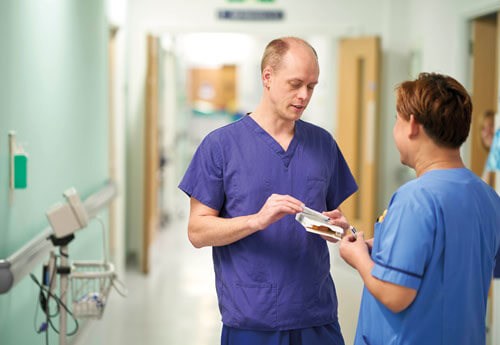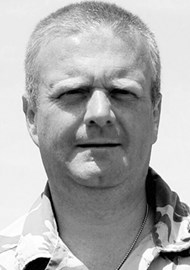The authors discuss the vital part teamwork, leadership and communication play in the complex management of burns patients.
Teamwork is a group of individuals collaboratively working together in the most efficient and effective manner to achieve a common goal [1,2]. The behaviour of an individual in coordinating and directing the team towards this goal can be defined as leadership [3,4]. Both teamwork and leadership are important in every specialty within medicine, particularly as the NHS places an ever-growing emphasis on the management of patients using a multidisciplinary team (MDT) approach. Nowhere is this approach more evident than in specialist burns centres, where 500 patients with the most severe of injuries are cared for annually in the UK [5].
Scientific advancements in the treatment and understanding of wound healing and management have greatly contributed to the decreasing morbidity and mortality of patients with severe burns. However, the efficacy of these advancements relies on a foundation of well organised and unified teams composed of professionals from a wide range of disciplines.
“Each discipline contributes an equal and essential service, but it is by working together, respecting each other and communicating effectively that optimal, holistic care for the patient can be achieved”
Professionals involved:
All team members within the burns centre are important, and in no particular order they include:
Burns consultants
As surgeons specialised in burns and plastic surgery, consultants regularly carry out procedures such as skin debridement, grafting and even amputations. They aim to provide the highest level of critical care required by patients in the centre, using their expertise to both lead and guide the multidisciplinary team [6]. Most importantly, consultants hold overall responsibility for the patient and the decisions made regarding their management; their name is ‘above the bed’.
Nurses
Comprising the largest segment of the burns centre team, nurses are responsible for the round-the-clock physical and, increasingly, psychological care of patients throughout their admission [6]. As a consequence, nursing staff are very familiar with the patients and their families and are usually the first to respond to a change in their condition.
Junior doctors
Junior doctors are responsible for the administration of the burns centre patients day to day. They organise investigations and identify any problems, supervised by more senior doctors and consultants.
Anaesthetists
As a result of their injuries, burns patients are often in an enormous amount of pain. Anaesthetists play a crucial role in managing this pain and providing comfort at all stages of treatment, from major operations, to physiotherapy sessions and dressing changes [6].
Physiotherapists and occupational therapists
Physiotherapists in the centre focus on early mobilisation, positioning, strengthening and splinting from day one of a patient’s admission. This is vital as a patient’s functional capacity diminishes very quickly following injury [7]. Occupational therapists work closely with both the patient and their family to help the patient re-adapt to activities of daily living and so maximise their independence.
Psychiatrists and psychologists
Due to the devastating nature of many severe burns injuries, it is vital that psychological and psychiatric support is provided to patients, many of whom experience a bereavement reaction to the loss of their ‘former self’. This care is also essential to facilitate a patient’s physical recovery, as it is well known that patients with pre-existing psychiatric disorders have poorer outcomes and an increased risk of mortality from a burns injury [8]. Post-traumatic stress disorder (PTSD) and other psychological consequences often outlast the physical ones, so it is important that mental support is provided, not only throughout admission, but out in the community setting following discharge.
Microbiologists
Microbiologists have an important role in preventing and treating infections, which are one of the commonest causes of significant morbidity and mortality amongst patients with severe burns injuries.
Other members of the MDT include dieticians, physician associates, social workers, speech and language therapists, pharmacists and medical students. It is important to remember that the care provided by these healthcare professionals will often extend beyond the patient themselves. For the patient’s friends and family, seeing their loved one suffer from a severe burn is often a traumatic and emotionally distressing experience, and so their subsequent psychological and social support requirements must not be underestimated [9].
Beyond discharge from the centre, burns patients are forced to deal with the life-long consequences of their injury and so they need to be engaged, motivated, and given the coping skills to do this, beginning from day one of their admission. One way this can be achieved is by ensuring that all professionals recognise that the patient is, in fact, always the most important member of the MDT. They should work with the patient, ensuring every effort is made to involve them at all stages of their care and keep their wishes at the forefront of any decision that is made.
The patient’s loved ones are also invaluable members of the MDT. They not only help to represent the patient’s wishes, but are usually involved in their long-term physical, psychological and social rehabilitation following discharge, and so should be recognised and incorporated into the patient’s management plan [9].

Nursing staff discussing a patient’s care in the centre.
The importance of teamwork
Optimal patient care cannot be achieved by a single person. The complexity of burns injuries demands the input and involvement from a wide range of healthcare professionals, all of whom possess the skills, experience and knowledge to address a certain aspect of a patient’s care. The multidisciplinary approach allows these professionals to come together in one place and collaboratively care for the patient, working together to overcome the unique challenges a severe burns injury can present [10].
However, what truly makes an effective team is the ability of these individuals, and the patient themselves, to work together in order to achieve a common goal. Particularly in the later stages of their recovery and rehabilitation, this goal should be dictated by the patient’s needs and wishes. Essentially, it is important that all members of the MDT adopt a horizontal approach to address their individual vertical priorities for the patient.
Central to the success of patient management in burns centres is effective communication, both with the patient and between team members. To ensure smooth functioning of the centre and to prevent or resolve any potential conflicts, professionals should maintain open and clear communication with one another. Positive relationships between staff members improves job satisfaction, which ultimately reflects favourably on patient care [11]. The MDT approach itself also helps to facilitate a higher level of staff satisfaction, by enabling the contributions of all team members to be recognised and respected [12]. This is particularly important given the long hours, intensive nature and high-stress working environment, where morale can often run low.
Leadership and followership
The leader of the MDT is normally the consultant surgeon, as he or she typically possesses the highest degree of knowledge and experience within the field. They act to direct and facilitate discussion, whilst motivating the team to achieve a common goal [13]. Present-day healthcare leadership has progressed from an authoritative nature, to one that is collaborative and driven by influence [13]. This means that consultants should lead by example, encouraging and inspiring their colleagues within a positive and constructive working environment, even in the face of adversity. It is important that the leader ensures every member of the team is made to feel valuable, and that their successes are regularly celebrated and rewarded. However, the leader must maintain their control over the decisions made regarding a patient’s management [6]. A good leader should be able to adapt their leadership style according to the situation, being assertive only when required.
Leadership, however, is only effective when the rest of the MDT are proficient in ‘followership’, that is, the ability and willingness to follow instructions as directed by the leader [14]. In healthcare, this is not a passive role; followers should exercise independent critical thinking whilst engaging with and supporting the leader to achieve a goal. Importantly, they must have the courage to challenge the leader and voice any concerns in a manner that does not undermine the leader’s authority, and to which the leader should be receptive [14]. Leadership is inextricably linked to followership and therefore, a greater understanding and appreciation of these roles will enhance the functioning of the burns centre team.

Interaction between a consultant and staff nurse in the burns centre.
Challenges of the MDT
As on any ward, staffing shortages, particularly those of nurses, can pose a huge challenge for the team, placing more pressure on those remaining. It is situations like these where effective teamwork and communication is vital in maintaining an excellent standard of care for patients. Perceptions of adequate staffing, as well as a high level of teamwork have been linked to improved job satisfaction amongst nurses on an acute medical unit [15]. This in turn helps to reduce the turnover of staff which would be both detrimental to the team and costly to the NHS.
Difficulties may also arise when there is a high level of transiency between members of the MDT. This is particularly the case for foundation year doctors, for which the burns centre represents only a fraction of their work within their rotation. As a result, there is often less familiarity within the team and with the day-to-day operation of the centre itself. These barriers can negatively impact on patient care as well as augment the stress experienced by newly-qualified doctors.
Potential improvements to the system
Enhancing communication within the centre is potentially the most effective way to improve teamwork. This could be achieved through a number of mediums. Firstly, from an organisational perspective, the team may benefit from having a centralised whiteboard system where the named nurse for each patient is listed, providing clarity to other team members, particularly junior doctors, who may not have a base at the centre. The board would also allow professionals to write important notes in regard to each patient, such as jobs required at a certain time, so that this is accessible to every member of the MDT. It also helps to reduce the potential for error, as there is not a reliance on verbal messages being passed along the team when the relevant member of staff is not present.
There may also be a place in the future for the use of technological applications such as WhatsApp within the centre to enhance communication. However, at present day this is not without its issues, importantly, data protection and confidentiality. Despite these aids it is important that verbal communication between the team is still maintained to preserve positive working relationships, prevent conflict and misunderstanding, and ultimately optimising the delivery of care to the patient.
Additionally, more organisational support from trusts could be provided to centres. Healthcare professionals are regularly required to attend training and educational events. Perhaps by incorporating team building activities, trusts can boost the cohesion of the team and improve morale. The programme would provide an informal, stress-free environment for professionals from different disciplines to interact with one another. Such a programme was implemented recently for nursing teams at the US Army Burn Centre, which was successful in its aim to improve teamwork and resiliency amongst nurses [16]. The programme was very well received by those involved, with many members expressing enthusiasm for the next event.
Conclusion
Due to the large number of specialties involved in managing the care of burns patients, a multidisciplinary approach is essential. The efficacy of this approach, however, is dependent on successful collaboration between all members of the team. Each discipline contributes an equal and essential service, but it is by working together, respecting each other and communicating effectively that optimal, holistic care for the patient can be achieved. It is the role of the leader, typically the consultant surgeon, to help maintain a positive and constructive environment for this to take place. Barriers to the effective running of a burns centre can be attributed to staff shortages, a rapid rotation of junior doctors and conflict and misunderstandings. Improvements in communication and relationships can go some way to alleviate this. A central board system can be implemented immediately, but no doubt technology will provide a more efficient mechanism in the near future.
References
1. Cambridge Academic Content Dictionary.
https://dictionary.cambridge.org/
dictionary/english/teamwork
2. Salas E, Cooke NJ, Rosen MA. On teams, teamwork, as well as team performance: discoveries and developments. Hum Factors 2008;50(3):540-7.
3. Al-Sawai A. Leadership of healthcare professionals: where do we stand? Oman Med J 2013;28(4):285-7.
4. Sfantou DF, Laliotis A, Patelarou AE, et al. Importance of leadership style towards quality of care measures in healthcare settings: a systematic review. Healthcare (Basel) 2017;5(4):73.
5. NHS England. NHS standard contract for specialised burns care [Service specification] 2014.
www.england.nhs.uk/wp-content/
uploads/2014/04/d06-spec-burn-care-0414.pdf
6. Al-Mousawi AM, Suman OE, Herndon DN. Teamwork for total burn care: burn centers and multidisciplinary burn teams. Total Burn Care 2012;4(1):9-13.
7. Taylor S, Manning S, Quarles J. A multidisciplinary approach to early mobilization of patients with burns. Crit Care Nurs Q 2013;36(1):56-62.
8. Hudson A, Al Youha S, Samargandi OA, Paletz J. Pre-existing psychiatric disorder in the burn patient is associated with worse outcomes. Burns 2017;43(5):973‑82.
9. Bäckström J. Family members of patients with burns: experiences of a distressful episode. Digital Comprehensive Summaries of Uppsala Dissertations from the Faculty of Medicine 935. 2013.
10. Al-Mousawi AM, Mecott-Rivera GA, Jeschke MG, Herndon DN. Burn teams and burn centers: the importance of a comprehensive team approach to burn care. Clin Plast Surg 2009;36(4):547-54.
11. Chang WY, Ma JC, Chiu HT, et al. Job satisfaction and perceptions of quality of patient care, collaboration and teamwork in acute care hospitals. J Adv Nurs 2009;65(9):1946-55.
12. Terheyden N. Fighting a shortage of skilled staff? Increasing teamwork and respect is as important as increasing salaries. 2016.
www.beckershospitalreview.com/
hospital-management-administration/
fighting-a-shortage-of-skilled-staff
-increasing-teamwork-and-respect
-is-as-important-as-increasing-salaries.html
13. Collins-Nakai R. Leadership in medicine. Mcgill J Med 2009;9(1):68-73.
14. Gibbons A, Bryant D. Followership: the forgotten part of doctors’ leadership. BMJ 2012;345:6715.
15. Kalisch BJ, Lee H, Rochman M. Nursing staff teamwork and job satisfaction. J Nurs Manag 2010;18(8):938-47.
16. Christiansen MF, Wallace A, Newton JM, et al. Improving teamwork and resiliency of burn center nurses through a standardized staff development program. J Burn Care Res 2017;38(4):708-14.
Last accessed February 2019.
Declaration of competing interests: None declared.
Acknowledgements:
Thank you to the Queen Elizabeth Birmingham Photography department for the photographs.
Comment from Andrew Burd, Editor, The PMFA Journal:
As a retired burn surgeon, I was delighted to read this clear and thoughtful article. I really appreciate the authorship with Emily being a Medical Student whilst Steven is an established leader in the field of burns care. This pairing is something that should be encouraged as a means of passing on wisdom from one generation to another.
I am taking this opportunity to share a couple of points that can add to the practical relevance of this article. The idea of the multidisciplinary team is very important in order that the contributions to the care of the patient, by the team members, is transparent, harmonious and complementary. A burns centre is however an organic entity which is more than the sum total of the patients and their professional carers. This was so clearly demonstrated to me by a wonderful and dedicated Ward Manager, Sherry Ng, who decided to tackle the vexing, global and perennial challenge of methicillin-resistant staphylococcus aureus (MRSA). She demonstrated true leadership in tackling this problem by looking at all the potential portals of entry of the bacterium into our centre in the Prince of Wales Hospital in Shatin, Hong Kong. When you start to log the entry of hospital personnel into the burns centre it is apparent that there are many ‘non-professional’ employees who enter, daily, weekly or even monthly. These include such people as the portering services, lab personnel, maintenance and administrative staff.
What Sherry did was to break out of the traditional, patient-centred model to elaborate a more inclusive model of interaction between the burns centre and the intrusive vectors of the external environment. This almost doubles the ‘MDT’. Through her passionate enthusiasm, patience and negotiating skills she was able to bring on board all of these human vectors in the battle against MRSA. It is so intuitively obvious but rarely discussed that it is not only patients, relatives and burns centre staff that pose an infection risk. Having a strict hand washing policy is fine if all adhere to it. I do wonder, however, how many ‘leaders’ in burns centres take it upon themselves to organise workshops for the support staff to bring them on board. Sherry did and we had a spell of 18 months with no positive swab of MRSA from the centre.
That brings me to another point. I appreciate the sentiment of keeping the consultants as the ‘leaders’ of the team but this must not be seen as an entitlement. Experience trumps professional status: a message to get through to our medical students and especially to that potentially dangerous creature, the newly appointed consultant! Another model that has been found useful is to have rotating leadership, certainly on the day to day organisational perspective. This does however mean revisiting the concepts of accountability from a medico-legal point of view (to be discussed in a future feature).
Finally, I have to say this, the word ‘followership’ is an example of legitimised jargon that sounds very awkward to the native English speaker. Of course, we can appreciate the counterpoint to leadership but it presents a binary perspective in what is so often a non-binary interaction (binary, by the way is another jargon term that has become part of the NHS culture where reference to colours is regarded with horror by some small minded and ‘politically correct’ management staff). A somewhat tongue in cheek comment but it is a reflection of how things change in culture and communication.
COMMENTS ARE WELCOME







